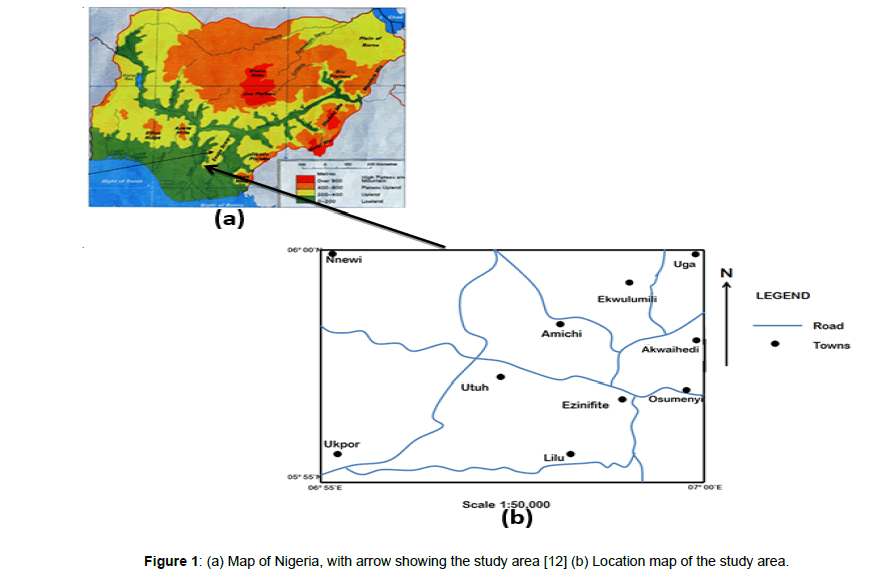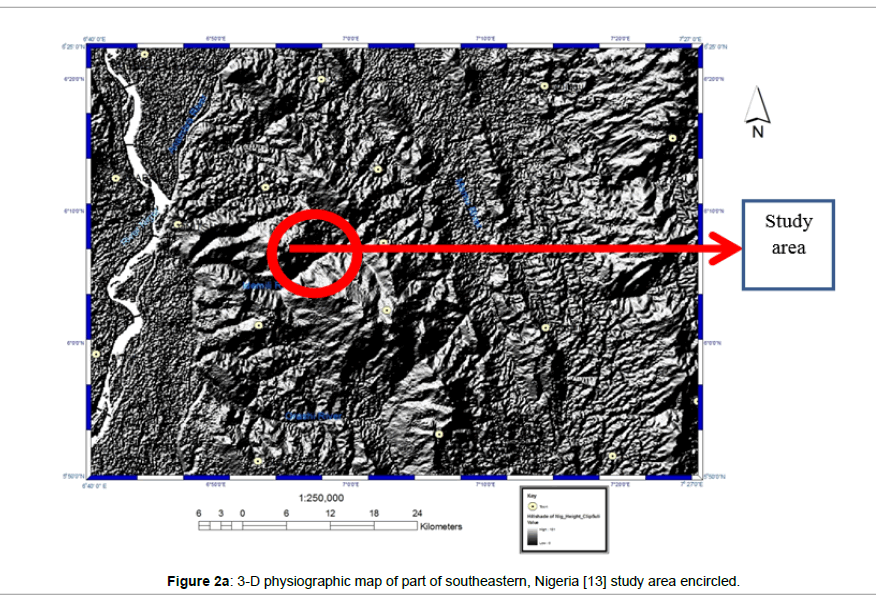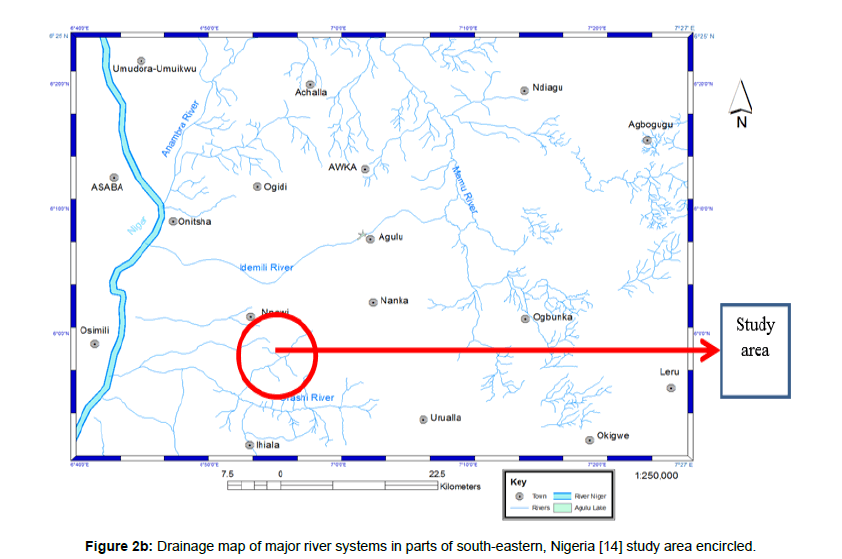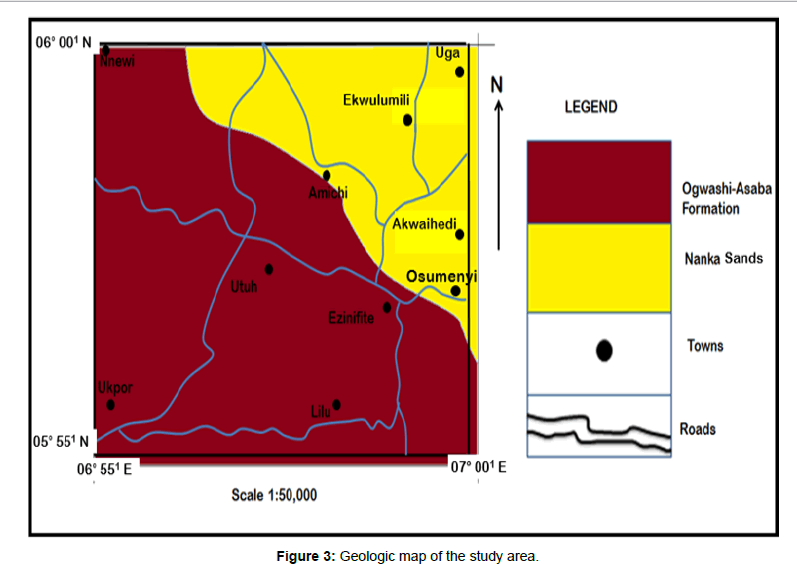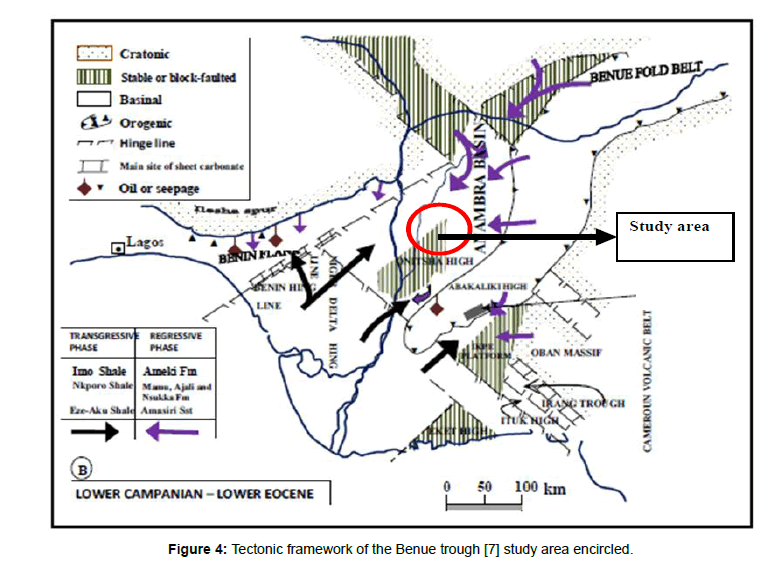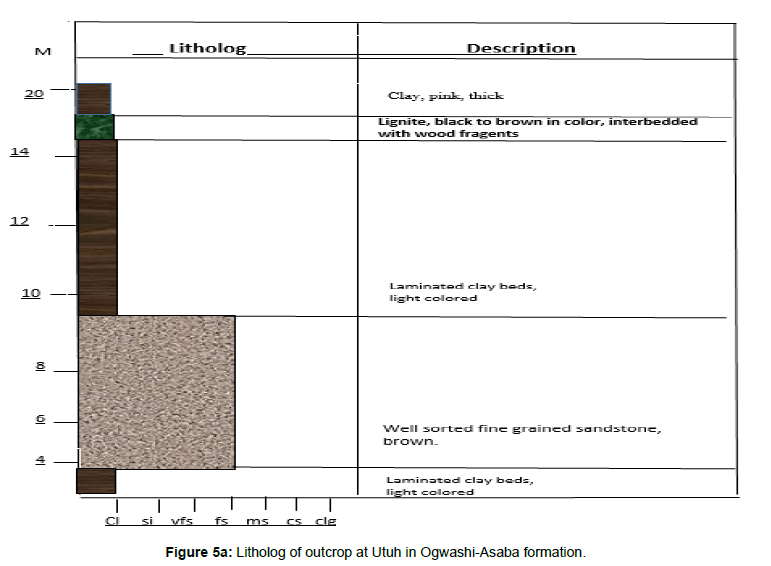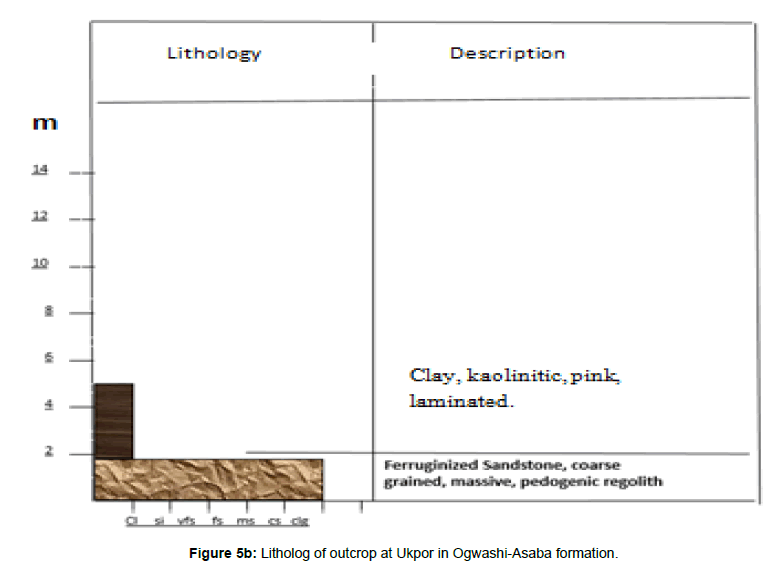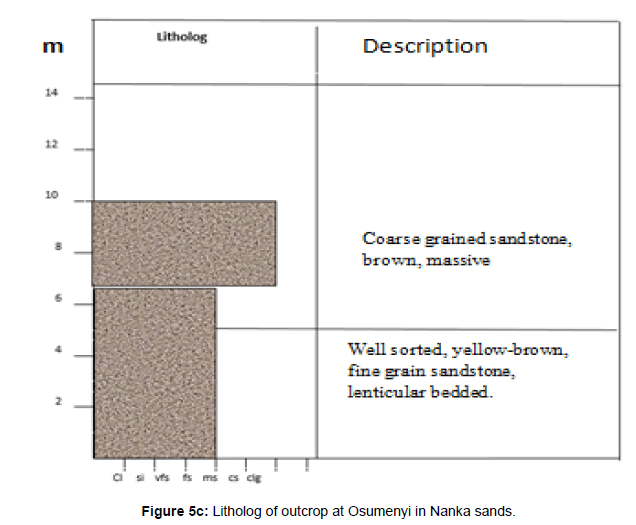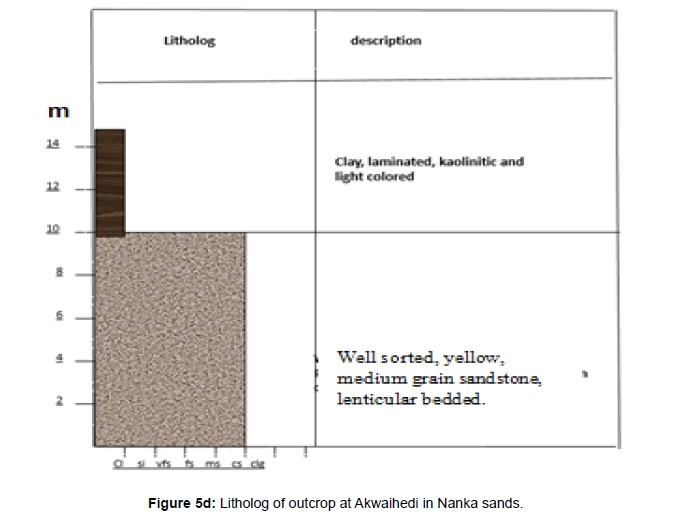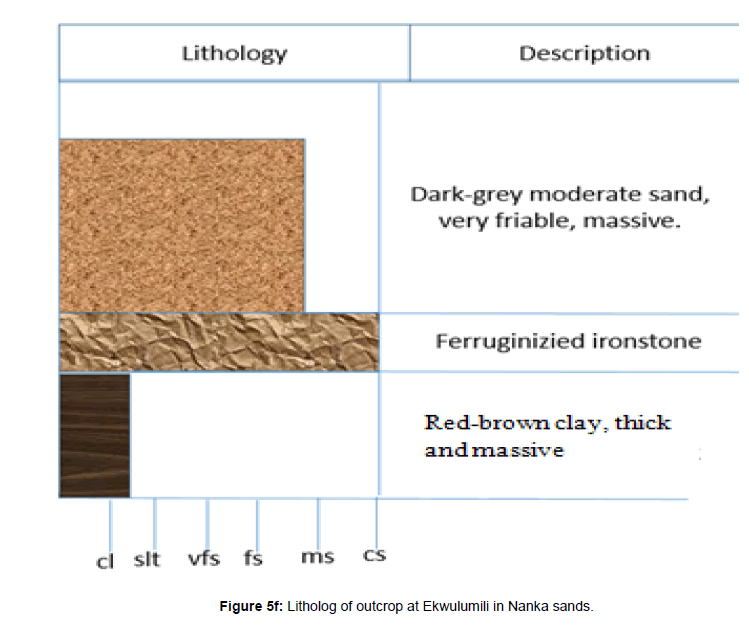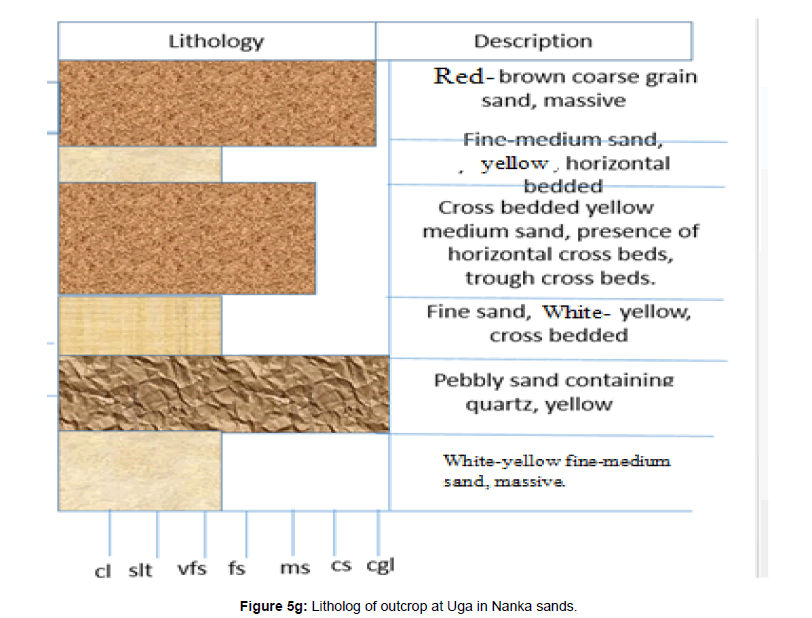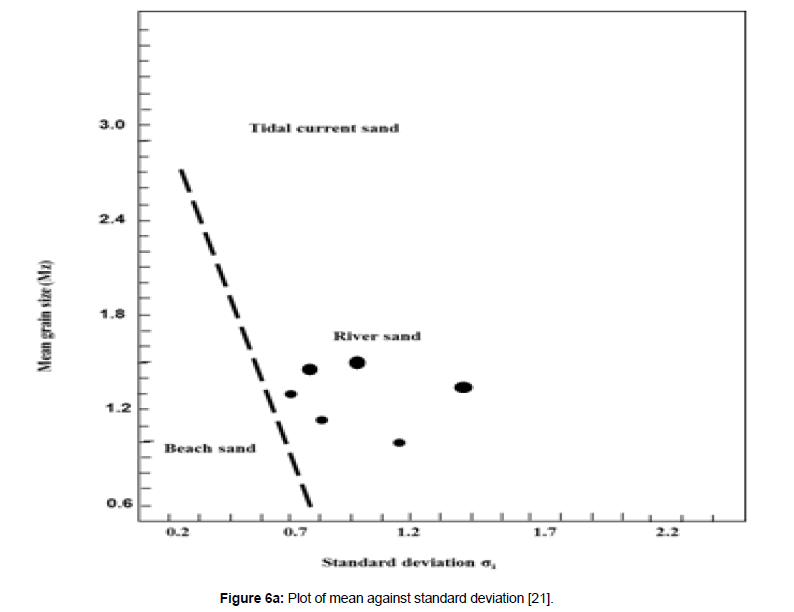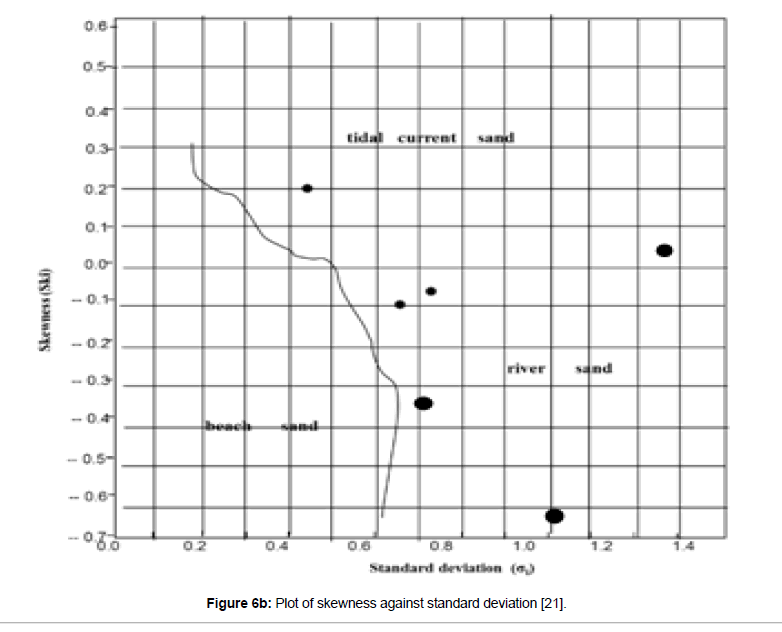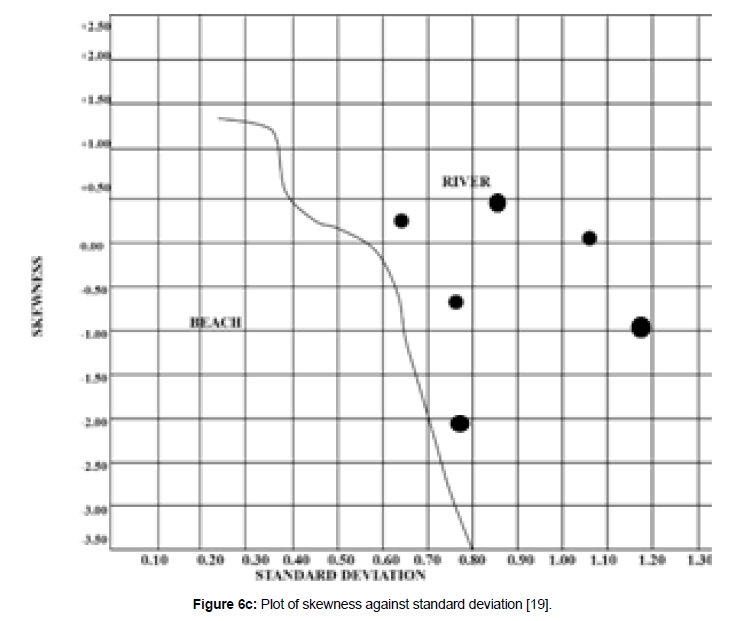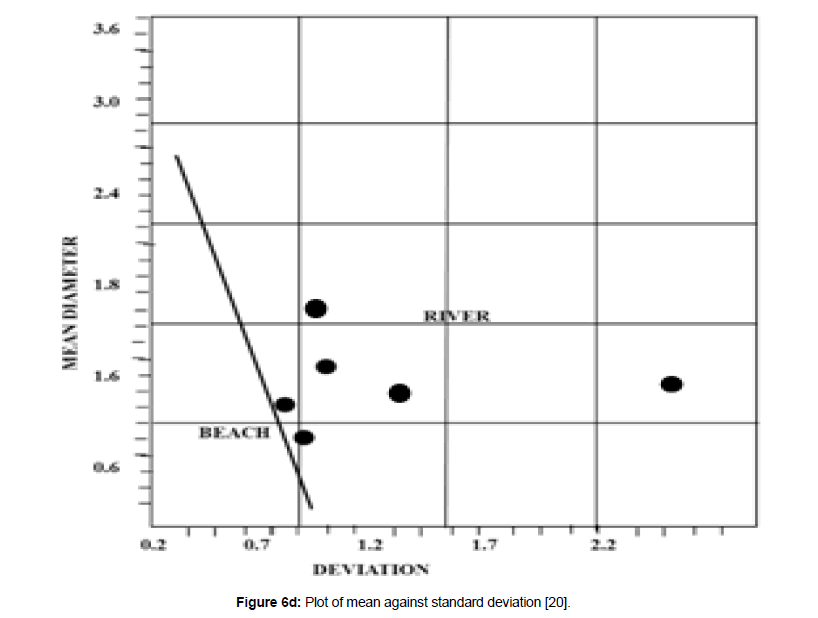Paleo-Environmental Deductions from Grain size Analysis: A Case Study of the Eocene - Oligocene Sand Facies in Osumenyi and Ukpor areas of South-Eastern, Nigeria
Received: 04-Nov-2018 / Accepted Date: 14-Mar-2019 / Published Date: 21-Mar-2019
Abstract
The Eocene–Oligocene sand facies is well exposed around Osumenyi and Ukpor areas in the Anambra Basin of southeastern Nigeria. Outcrop sections were located, measured, described in detail and sampled so as to decipher the paleoenvironment of deposition, using an integration of sedimentary facies and grain size analyses. The sedimentary facies study suggests that the Eocene– Oligocene age in this area consist mainly of three facies association; sandstone, lignite and clay facies. The fine-grained sandstone sub-facies is indicative of shoreface, the medium grained sandstone sub-facies is indicative of estuarine, while the coarse-grained sandstone sub-facies suggests a fluvial environment. The lignite facies indicate a continental origin (swamp environment) while the clay facies are interpreted as fluvially intercepted shallow marine environment. Results of grain-size analysis for the Eocene– Oligocene age show that the sands are medium grained, moderately to poorly sorted, very negatively to positively skewed and very platykurtic to very leptokurtic. Bivariate plots of mean size against standard deviation and skewness against standard deviation support a fluvially dominated shallow marine environment with tidal crosscuts. Result of multivariate functions showed a fluvially intercepted shallow marine environment. This study is significant in providing evidence for the reservoir potentials and aquifer characteristics of the Eocene – Oligocene sand facies for petroleum accumulation and prolific water bearing units within the basin.
Keywords: Eocene–Oligocene sand facies; Anambra Basin; Paleoenvironment; Grainsize analysis; Reservoir potentials; Petroleum accumulation
Introduction
The Eocene and Oligocene are two distinct ages recorded within the Anambra Basin. The paleoenvironment of the Eocene sand facies has been considered to be tidal-estuarine while that of Oligocene sand facies is considered to be an upper flood plain environment [1-11]. Recent research in this area are still ongoing and this paper is an attempt to compliment the findings of earlier workers on paleoenvironmental condition that prevailed during the Eocene-Oligocene times. Geological field studies were carried out at Ukpor, Amichi, Utuh, Osumenyi, Ekwulumili, Akwaihedi and Uga areas of southeast Nigeria. Outcrops were located and studied in detail and the underlying formations noted. The lithologies encountered were mainly sands, clay, kaolin, lignite and embedded pebbles. The outcrops were systematically described and recorded. Fresh sand samples were collected from various locations for sieve analytical study. The study area is located within the area bounded by Longitudes 06°551 E and 07°001 E and Latitudes 05°551 N and 06°001 N (Figure 1) and covers a total surface area of 256 km2. The objective of this research paper is to decipher the paleoenvironment of deposition of sands from grain size analysis in the area.
Physiography and Drainage
The prominent physiographic feature in the study area is the Awka-Oraukwu-Orlu cuesta which is characterized by an undulating topography made up of highlands and lowlands. The highlands are made up of sandstones while the lowlands are mainly shaly terrain. The uplands are separated from one another by rivers, streams and dry valleys. The lowlands are generally less than 100 meters above mean sea level with a regional slope of 20 westwards (Figure 2a) [12,13].
The drainage pattern of the study area is largely determined by the topography, structure and underlying rock type, and is naturally well drained by flowing rivers, perennial and seasonal streams, and rivulets. The drainage system in the area is dendritic (Figure 2b).
Climate and Vegetation
The study area falls within the humid tropical belt of the world and is characterized by two major seasons; rainy and dry season. The rainy season begins in March and ends in October with a break in August usually referred to as the August break. The dry season which last for four months begins in November and ends in February. Annual rainfall is between 1,400 mm and 2,250 mm. The relative humidity is 23% with daily temperature range of 24°C to 27°C but as low as 17°C to 20°C at night. The annual pressure ranges from 1010.0 millibars to 1072.9 millibars [14,15]. The study area falls within the Evergreen rainforest belt of Nigeria [12]. The heavy rainforest belt is characterized by growth of tall trees. Oil Palm trees dominate the landscape. Other species are Iroko, Mahogany, Obeche and Oil bean.
Geologic Setting
The study area is underlain by two geologic formations; Nanka Sands and Ogwashi – Asaba Formation which are Eocene and Oligocene in age respectively. The Nanka Sands underlie the northeastern section of the study area which covers areas around Amichi, Akwaihedi, Osumenyi, Ekwulumili and Uga. The Ogwashi-Asaba Formation underlie the central and southwestern section covering Ukpor and Utuh communities (Figure 3). The study area lies within the Anambra Basin. The basin is a Cretaceous depocenter that received Campanian to Tertiary sediments [7,16]. The Anambra Basin results from the Santonian upliftment of the Abakaliki region, of the Benue Trough (Figure 4). The Anambra Basin roughly triangular in shape covers an area of about 40,000 Km2. The Eocene age was characterized by regressive phase that led to deposition of Ameki Group comprising Nanka Sands and Ameki Formation [16]. The Ameki Group is overlain by the Oligocene Ogwashi-Asaba Formation [1]. The Benin Formation (Miocene to Recent) prograde unto the surface of the Anambra Basin [17].
Sedimentary facies
In this study, six outcrops were systematically logged at various locations (Utuh, Osumenyi, Akwaihedi, Ukpor and Amichi). The lithologies in the study area consist of three facies association: the sandstone facies, the lignite facies, and the clay facies.
Sandstone facies
The sandstone consists of three subfacies: the fine-grained sandstone subfacies (Figures 5a, 5b and 5g), with thickness of about 10 meters. It is well sorted, generally laminated, contain Ophiomorpha burrows. The medium grained sandstone subfacies (Figures 5c, 5d, 5f and 5g): its thickness varies from about 3 meters to 6 meters. It is well sorted, lenticular bedded, trough crossbedded and locally horizontally bedded, contains few Ophiomorpha burrows, white-yellow in color. The coarse-grained sandstone subfacies (Figures 5c, 5e, 5f and 5g): its thickness varies from about 7 meters to 13 meters. It is poorly sorted. The prominent sedimentary structure is planar cross bedding and is occasionally ferruginized with rare pebble imbrication.
Lignite facies
It is about 6 meters thick (Figure 5a), bounded at the top and bottom by thick clay beds. The lignite is found in association with wood fragments. It is black to brownish in color and outcrops as lignite streak at this section. The lignite facies are characteristic of the Oligocene age in the Anambra Basin.
Clay facies
It is seen in most of the locations (Figures 5a, 5c, 5d, 5e and 5f). It consists of clays which are light colored, sometimes pink, laminated, occasionally kaolinitic and brown on weathered surface. Its thickness varies from about 10 meters to 18 meters.
Methodology
Fresh samples of sands were collected from each sand outcrop studied. The analysis carried out on the samples for grain size optimization was sieve analysis. The equipment used during the laboratory studies include; Weighing balance, result sheet, stop watch, Set of sieves, and Sieve shaker. Sieve analysis technique was used for the textural studies and it usually depends on the grain size of the material to be examined and is applied for sand-size particles. The samples were properly disaggregated and the required quantity (50 g) carefully measured out. The 50 g measured out is sieved on a Ro-tap Sieve shaker for 15 minutes using a US standard sieve. Samples retained in each sieve size on the stack were collected, weighed and the weight recorded. The data obtained is tabulated and a graph of cumulative frequency against Phi is plotted on the Ogive curve graph, from which the following parameters were determined; mean size, sorting, skewness and kurtosis. The descriptive measure of grain size distribution is shown in Table 1 [18].
| Parameters | Formular | Specification |
|---|---|---|
| Mean size, Mz | Q16+Q50+Q84 3 |
0 -1 Coarse sand |
| 1 - 2 Medium sand | ||
| 2 - 3 Fine sand | ||
| Sorting, Qi | Q84-Q16+Q95-Q5 4 6.6 |
<0.35 Very well sorted |
| 0.35 - 0.50 Well sorted | ||
| 0.5 – 1.0 Moderately well sorted | ||
| 1.0 – 2.0 Poorly sorted | ||
| 2.0 – 4.0 Very poorly sorted | ||
| >4.0 Extremely poorly sorted | ||
| Skewness, Ski | Q16+Q84-2(Q50)+Q5+Q95-2(Q50) 2(Q84-Q16) 2(Q95-Q5) |
1.0 - 0.3 Very positively skewed |
| 0.3 - 0.1 Positively skewed | ||
| 0.1 - (-0.1) Symmetrical | ||
| -0.1- (-0.3) Negatively skewed | ||
| -0.3 – (-1.0) Very negatively skewed | ||
| Kurtosis, KG | Q95-Q5 2.44(Q75-Q25) |
<0.67 Very platykurtic |
| 0.67 – 0.90 Platykurtic | ||
| 0.90 – 1.11 Mesokurtic | ||
| 1.50 – 3.0 Very leptokurtic | ||
| >3.0 Extremely leptokurtic |
Table 1: Descriptive measures of grain size distribution [18].
Bivariate plots
Bivariate plot of textural parameters has also been found to be useful in differentiating adjacent environments. used plots of skewness against standard deviation to differentiate river and beach sands [19,20]. used a plot of mean size against standard deviation to distinguish between river and beach sands. However, the best separation is achieved using a combination of standard deviation and skewness.
Multivariate analysis
Several functions have been established by multivariate analysis in order to distinguish between adjacent mechanisms and environment having closely similar energy conditions. Some of the functions are highlighted in Table 2.
| Functions | Verbal terms |
|---|---|
| Y beach: shallow marine=15.6534 Mz+65.7091s2+18.1071 Ski+18.5043 KG | Y<65.3650=Beach deposition |
| Y>65.3650=Shallow marine deposition | |
| Y shallow marine: fluvial=0.2852 Mz-8.7604 s2-4.8932 Sk+0.0482 KG | Y<-7.419=Fluvial deposition |
| Y>-7.419=Shallow marine deposition |
Table 2: The multivariate functions.
Results and Discussion
The computed grain size parameters and their verbal terms for Akwaihedi, Amichi and Utuh sand outcrops using results from graphic method are shown in Table 3. Certain textural parameters such as; graphic mean, inclusive graphic standard deviation (sorting), inclusive graphic skewness, and kurtosis were obtained so as to use the standard plots of [19-21] decipher the paleoenvironment of deposition of the Eocene to Oligocene sands within the Anambra Basin. The plots are shown in Figures 6a-6d. The results from multivariate sieve analysis are also shown in Table 4.
| Sample No |
Mean Size (M2) |
Sorting | Skewness | Kurtosis |
|---|---|---|---|---|
| (d1) | (SK1) | (KG) | ||
| Uga/05/001 | 0.93 Coarse sand | 1.247 Poorly sorted | -0.71 Very negatively skewed | 1.26 Leptokurtic |
| Uga/05/002 | 1.633 Medium sand | 2.03 Poorly sorted | 0.213 Positively skewed | 0.36 Very platykurtic |
| Ekwu/06/001 | 1.7 Medium sand | 1.302 Poorly sorted | 1.635 Positively skewed | 1.639 Very leptokurtic |
| Ami/03/001 | 1.03 Medium sand | 1.1.5 Poorly sorted | 0.16 Positively skewed | 0.91 Mesokurtic |
| Utuh/01/002 | 1.35 Medium sand | 0.64 Moderately sorted | 0.21 Positively skewed | 1.17 Leptokurtic |
| Akwa/04/001 | 1.07 Medium sand | 0.78 Moderately sorted | -0.11 Negatively skewed | 0.98 Mesokurtic |
Table 3: Data obtained from univariate parameters.
| S. No | Sample Name | YShallow Marine:Fluvial | YBeach:Shallow Marine |
|---|---|---|---|
| 1 | Ami/03/001 | -12.0308 Fluvial | 70.9999 Shallow Marine |
| 2 | Utuh/01/002 | -4.1744 shallow marine | 73.4990 Shallow Marine |
| 3 | Akwa/04/001 | -4.4391 shallow marine | 72.8689 Shallow Marine |
| 4 | Uga/05/001 | -7.119 Shallow marine | 100.23 Shallow Marine |
| 5 | Uga/05/002 | -18.344 Fluvial | 63.4990 Shallow Marine |
| 6 | Ekwu/06/001 | -18.851 Fluvial | 79.7461 Shallow Marine |
Table 4: Summary of multivariate grain-size analysis.
Grain size analysis
From the computed grain size parameters and their respective verbal terms, we can observe that the samples are dominantly medium grained sands. The results of standard deviation for the sands range from 0.64 to 2.03 which suggest that it is moderately to poorly sorted. The results of skewness range from -0.71 to 1.635 which suggest very negatively to positively skewed. The results of kurtosis for the sand range from 0.36 to 1.639 which indicate it is very platykurtic to very leptokurtic. Bivariate plots of mean size against standard deviation and skewness against standard deviation for the Eocene to Oligocene sands indicate a fluvially dominated shallow marine setting with tidal interferences. From the results of multivariate sieve analysis a fluvially intercepted shallow marine condition is deduced. Also from the univariate grainsize analysis results which indicated that the sands are medium grained, and the lithofacies classification scheme, the sands of the Eocene to Oligocene age in the study area can serve as good potential reservoir rocks for underlying source rocks and high yielding aquifers when exploited (Table 5).
| Sediment Type | Lithofacies Description | Code | Classification | % Abundant in the outcrops | |
|---|---|---|---|---|---|
| Sandstone <20% clay | Pebbly sandstone | Ps | Reservoir | ||
| Fine to coarse grained Cm- scale cross-bedded sandstone | Sx | 100 | |||
| Very fine-grained mm-scale laminated sandstone | Sl | ||||
| Very fine to fine grained laminted sandstone with clay drape | Sc | ||||
| Bioturbated sandstone | Sb | ||||
| Mixed sand and clay (Heterolith 20% - 80% clay |
Sand rich heteroliths <20-50% clay | Wavy-bedded sandy heterolith | SMw | ||
| Bioturbated sandy heterolith | SMb | ||||
| Muddy sandstone | S Mshg | ||||
| Mud rich heteroliths <50-80% clay | Lens-bedded muddy heterolith | Mst | Non- Reservoir | ||
| Bioturbated muddy heterolith | Msb | ||||
| Mudstone >80% clay | Bedded or massive mudstone | Mb | |||
| Sideritc-bedded mudstone | Msb | ||||
Table 5: Lithofacies classification scheme showing the percentage abundance of the lithofacies in an outcrop.
Sedimentary facies
The sedimentary structures and facies association of the Eocene to Oligocene in the area are suggestive of deposition in a fluvially intercepted shallow marine environment with tidal footprints. The fine grained sandstone subfacies, which is well sorted, is indicative of a shoreface deposit. The medium grained sandstone subfacies, which is also well sorted, contains few Ophiomorpha burrows and lenticular beddings is suggestive of estuarine. The coarse grained sandstone subfacies, which is poorly sorted, planar cross bedded, rare pebble imbrication and locally ferruginized is suggestive of fluvial environment. The lignite facies with presence of some wood fragment indicate a continental origin, the interbedding with clay facies which is light colored and kaolinitic is suggestive of fluvially intercepted shallow marine environment.
Conclusion
The grainsize analysis unveils that the univariate parameters indicate a fluvial dominated shallow marine setting. Also from bivariate plots; a fluvially dominated shallow marine setting with tidal interferences is interpreted. The multivariate function showed a fluvially intercepted shallow marine condition. The sedimentary facies analysis suggest a fluvially intercepted shallow marine system characterized by shoreface, tidal, shallow marine and dominated by fluvial deposits. In conclusion, the paleoenvironment of the Eocene to Oligocene sands in Osumenyi and Ukpor areas of southeastern Nigeria have been deciphered using grainsize analysis and it indicated a fluvially intercepted shallow marine environment with tidal footprints. This research also shows that these sands can serve as good reservoir rocks for petroleum accumulation within the basin and high yielding aquifers when exploited.
References
- Reyment RA (1965) Aspects of the geology of Nigeria. Ibadan University Press, Nigeria. pp: 145.
- Nwajide CS (1979) A lithostratigraphic analysis of the Nanka Sand South-Eastern Nigeria. J Geol Min 16: 103-109.
- Arua I (1981) The Nigerian sedimentary characteristics of the Ameki group with appendices by Newton, R.B and Seward, A.C. Geol Surv Niger Bull 8: 23-30.
- Arua I (1986) Paleoenvironment of eocene deposits in the Afikpo Syncline, Southern Nigeria. J Afr Earth Sci 8: 279-284.
- Hoque M, Nwajide CS (1984) Tectono-sedimentological evolution of elongate intracratonic basin (aulacogen): The case of the Benue Trough of Nigeria. J Geol Min 21: 19-26.
- Arua I, Rao VR (1987) New stratigraphic data on the Eocene Ameki Formation, South-Eastern Nigeria.J Afr Earth Sci 8: 391-397.
- Nwajide CS (1990) Cretaceous sedimentation and paleogeography of the Cental Benue Trough. In: Ofoegbu, CO (Ed). The Benue Trough structural and evolution. Braunschweigh, International monograph series, Germany pp:19-38.
- Egboka BCE, Nwankwor GI, Orajaka IP (1993) Implications of paleo and geotectonics in gully erosion prone areas of southern Nigerian. Kluwer Academic Publisher, Nigeria. 3: 210-230.
- Nwajide CS (2013) Geology of Nigeria’s sedimentary basins. Lagos, CSS Bookshop Limited, Nigeria pp: 565.
- Umeji OP (2002) Mid-tertiary (Late Eocene-Early Miocene) age of lignites from Mpu Formation of Abakaliki Basin, South-eastern Nigeria. J Geol Min 38: 111-116.
- Umeji AC (2003) Tertiary plantation surface on the cuesta in South-eastern Nigeria. J Geol Min 17: 109-117.
- Balogun OY (2009) Senior Secondary Atlas. (2nd edn). Lagos, Longman Nigeria Plc, Nigeria pp:123.
- Okpoko EI (2018) Physico-chemical and microbial analyses of groundwater from the upper cretaceous deposits underlying parts of Udi and Eziagu areas of southeast, Nigeria. Afr J Environ Res 1: 25-41.
- Okpoko EI (2018b) Improving the Socio-economic wellbeing of the People of Aguleri area through Water Resources Development. Afr J Environ Res 1: 25-41.
- Monanu JC, Inyang PGB (1975) Climatic regions. In: Ofomata, G.E.K. (Ed). Nigeria in maps, Eastern States, pp: 27-29.
- Obi GC (2000) Depositional model for the Campaniaan-Maastrichtian Anambra Basin, Southeastern, Nigeria. Department of Geology, University of Nigeria, Nsukka pp: 286.
- Odumodu CFR (2014) Pebble form indices as signatures of the depositional environment of the Benin Formation along Atamiri River, Uli, Southeastern Nigeria. Int J Sci Tech Res 3: 23-32.
- Folk RL, Ward WC (1957) A study in the significance of grain size parameter. J Petrol 37: 327-354.
- Friedman GM (1961) Distribution between dune, beach and river sands from their textural characteristics. J Sediment Petrol 31: 514-529.
- Moiola RJ, Weiser D (1968) Textural parameters: An evaluation. J Sediment Petrol 33: 45-53.
- Lui ZX, Xia DX, Berne S, Kui Yang W, Marsset T, et al. (1989) Total depositional systems of China’s continental shelf with special reference to the Eastern Bohai Sea. J Mar Geol 145: 225-493.
Citation: Chidera Ikechukwu V, Egbunike Michael E, Okpoko Ephraim I, Okpala Emmanuel C, Onwuka Chisom J (2019) Paleo-Environmental Deductions from Grain size Analysis: A Case Study of the Eocene – Oligocene Sand Facies in Osumenyi and Ukpor areas of South-Eastern, Nigeria . J Earth Sci Clim Change 10:512.
Copyright: © 2019 Chidera Ikechukwu V, et al. This is an open-access article distributed under the terms of the Creative Commons Attribution License, which permits unrestricted use, distribution, and reproduction in any medium, provided the original author and source are credited.
Select your language of interest to view the total content in your interested language
Share This Article
Recommended Journals
Open Access Journals
Article Usage
- Total views: 3711
- [From(publication date): 0-2019 - Dec 09, 2025]
- Breakdown by view type
- HTML page views: 2782
- PDF downloads: 929

